|
|
 |
|
|
Canadian Rural Partnership
Research and Analysis

The Information Highway and the
Canadian Communications Household:
A Rural Perspective
Final Report - July 30, 1999
Submitted to:
Rural Secretariat
Agriculture and Agri-Food Canada
3rd floor
1525 Carling Avenue,
Ottawa, Ontario
K1A 0C5
E-mail: rs@agr.gc.ca |
Submitted by:
Ekos Research Associates Inc.
Head Office:
99 Metcalfe Street, Suite 1100,
Ottawa, Ontario, K1P 6L7
Tel.: (613) 235-7215
Fax: (613) 235-8498
E-mail: pobox@ekos.com |
The Information Highway and
the Canadian Communications
Household: A Rural Perspective

1 Introduction
- Over the course of a short period of time, the information highway has moved from
relative obscurity to become increasingly part of the mainstream, and a vital necessity
in the day-to-day lives of many Canadians.
- Despite this rapid growth, however, Canadians' use of the information highway differs
significantly depending on where they live. Ekos Research Associate's research into
the information highway revealed that many of the key indicators of usage are much
lower in rural areas across the country. Closely related, the research also showed that
many of the same indicators of usage were correlated with the size of the cities and
communities where Canadians live with usage rising as the size increases.
- Given that one fifth of the Canadian population live in rural areas, and many others
in smaller communities, it is critical to have a better understanding of these differences.
It was within this context that this follow-up study arose. The findings in this study are
based on Ekos' Information Highway and the Canadian Communications Household
study. Launched in 1997, the purpose of this study was to break new ground in
understanding the social and economic consequences of the information highway.


2 Methodology
- The original Information Highway and Canadian Communications Household study
involved three different waves of research.
- The first wave involved a telephone survey with a national random sample of
3,522 Canadians aged 18 and over, conducted in September 1997.
- As a next step, a mail-back questionnaire was sent to the three in four respondents
from the first wave that had agreed to a follow-up interview. The results from this
second wave are based on 1,271 completed surveys received between February
and April 1998.
- The third wave, conducted in June 1998, involved a final telephone survey with
1,767 of the respondents who had participated in the first wave. Another 434
interviews were also conducted with a random sample of Canadians who had not
previously participated in the study. As such, the results from the third wave are
based on 2,201 interviews.
- Accordingly, the sampling errors from the three waves are +/- 1.7, +/- 2.7 and +/-
2.1 percentage points, 19 times out of 20
- The demographic profile of respondents from the benchmark survey before a weighting scheme was applied is included in Table 1. In terms of reporting, the findings were weighted along age, gender and regional lines to ensure that the sample is representative of the general public. Given various differences between Internet users and non-users, the findings in the last two waves were also weighted according to Internet usage.
- For the purposes of this report, the findings have been segmented on a rural and urban basis according to the postal code associated with the telephone number of an individual called. That is, postal codes with a zero in the second position are defined as rural (e.g., K0A 1S4). Other postal codes are defined as urban. The findings have also been segmented according to the size of the city or community as provided by the individuals during the course of the interviews. Finally, the findings reflect differences between rural respondents who live on farms.
Table 1
Demographic Profile of Respondents from Benchmark Survey
(Unweighted Data)
| |
Rural
(n=888)
|
Urban
(n=2608)
|
Gender |
| Male |
42% |
46% |
| Female |
58% |
54% |
| Age |
| Less than 25 |
9 % |
13% |
| 25 to 34 |
20% |
24% |
| 35 to 44 |
29% |
27% |
| 45 to 54 |
21% |
18% |
| 55 to 64 |
12% |
10% |
| 65 and over |
9% |
7% |
| Household income |
| Less than 20,000 |
15% |
13% |
| 20,000 to 39,999 |
28% |
25% |
| 40,000 to 59,999 |
24% |
21% |
| 60,000 to 79,999 |
10% |
14% |
| 80,000 and over |
8% |
14% |


3 Overview of Findings
- The findings are presented in six broad areas: awareness and images; usage and
ownership; barriers to the information highway; government and technology; and
electronic commerce.
- While this report focuses on differences according to the type of community where
respondents live (i.e., rural/urban; settlement size, and farm/non-farm differences), it is
important to recognize that one of the principal findings from the original study was
the extent to which usage of some technologies remains highly polarized, along
generational, gender and social class lines. These basic demographic characteristics
are key determinants of awareness, knowledge, behaviour and broad attitudes, and are
at the centre of how Canadians view the information highway and their place within it.
3.1 Awareness and Images
- The original study revealed that images and awareness of the information highway are
mixed and very much in flux.
- While a significant number of Canadians are unfamiliar with the "information
highway", many others say that they are at least somewhat familiar.
- Compared to the large differences observed along basic demographic lines such as
age, income and education, those living in rural areas were only slightly less familiar
with the term (55 per cent compared with 65 per cent of urban respondents being at
least "somewhat familiar") [Exhibit 1]. These differences were also similar to those
between the smallest communities with fewer than 1,000 inhabitants and those in
excess of 500,000 inhabitants, although more pronounced (53 per cent compared with
75 per cent). Differences between farm and non-farm rural respondents are minimal.

- One of the more striking findings of the broader study was the decisively positive
lean to a favourable and optimistic image of the information highway, although differences
exist along some of the divisions mentioned above. Like most urban respondents,
those living in rural areas had similarly positive imagery although at times it was
slightly less pronounced.
- At the same time, information highway issues are seen as real and matter to both rural
and urban Canadians. More than two in three rural respondents believe that these
issues are important (69 per cent) with only 31 per cent not sharing this view. Urban
respondents, however, are even more positive in their views with only 22 per cent
saying that these issues are not important [Exhibit 2].

3.2 Usage and Ownership
Recent usage of technology
- The extent to which newer technologies - many of which were not widely available
only five or ten years ago - have become commonplace is notable.
- As shown in Exhibit 3, a significant number of rural and urban Canadians are taking
advantage of a number of relatively new products and services. In most cases, usage of
many of these technologies in rural areas lagged behind the levels in urban areas,
although the differences were not always large.
- Despite trailing urban respondents, widespread use of computers in rural areas is clear with more than one in two reporting recent experiences with a personal computer - a proportion that only fell below VCRs and essentially the same as cable television.
- Given that the availability of cable television is limited in some rural areas, it is
not surprising that recent usage was much lower in rural areas (56 per cent
compared to 85 per cent in urban areas). As might be expected in light of access
considerations, satellite television had been used slightly more frequently in rural
areas (21 per cent compared to 14 per cent in urban areas).
- There was a relatively larger gap in terms of Internet usage with a difference of
12 percentage points (28 per cent in rural areas compared to 40 per cent in urban
areas).
- Cellular phones had been used by more than one in three in both rural and urban
areas (36 per cent and 45 per cent respectively).
- Differences between farm and non-farm rural respondents in their usage of the
technologies examined were not statistically significant except in relation to cable
television (26 per cent and 60 per cent respectively).

- On the other hand, Exhibit 4 shows that the gaps in terms of usage of personal
computers and the Internet are closely correlated to the settlement size.
- While 47 per cent of respondents living in communities with fewer than 1,000
inhabitants had used a personal computer, the proportion rises to 73 per cent in
centres with more than 500,000 inhabitants.
- Likewise, only 24 per cent of respondents in the smallest communities had
recently used the Internet as compared to 49 per cent in the largest.

Where computers and the Internet are being used
- As with urban areas, the household remains the dominant location where rural
Canadians are using computers and the Internet, although many have used them
elsewhere [Exhibit 5].
- More than three in four rural respondents who had used a personal computer
recently had done so at home - a proportion almost identical to urban areas.
- Rural respondents were also almost as likely to have used the Internet at home (52
per cent as compared to 57 per cent).
- By contrast, rural respondents were far less likely than urban respondents to have
used computers or the Internet in the workplace. While 51 per cent of urban
computer users had done so at work, the corresponding level was 37 per cent in
rural areas. Likewise, only 26 per cent of rural users had used the Internet at work
as compared to 35 per cent of urban users.
- Reported usage in schools, public access sites and elsewhere did not differ sharply between rural and urban areas.
- The same broad patterns were evident along community size with respondents in
the largest urban centres being more likely to have used computers or the Internet
in the workplace [Exhibit 6]. Differences between farm and non-farm rural respondents were minimal.
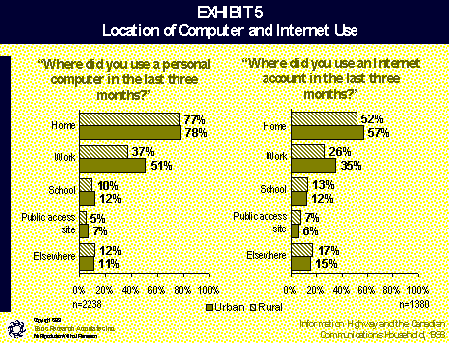

Access and Ownership
- The degree to which personal computers and the Internet have become common
features in many Canadian households is well documented. A majority of Canadians
(57 per cent) reported having a personal computer in their household in September
1997, and 28 reported home Internet access. 1
- As shown in Exhibit 7, higher computer and Internet penetration rates were reported in
urban areas (60 per cent computers vs. 50 per cent in rural areas; 30 per cent Internet
vs. 20 per cent in rural areas).
1. (It is recognized that these findings may over-represent the incidence of computer and Internet in households, although other studies point to similar penetration rates. By comparison,
Statistics Canada 1997 estimate put the computer penetration rate at 36 per cent of households. The original study pointed to possible explanations
relating to time lags, definitional differences, the fact that telephone surveys typically under represent those at the lowest end of the socio-economic status and the possibility of a social desirability bias.)
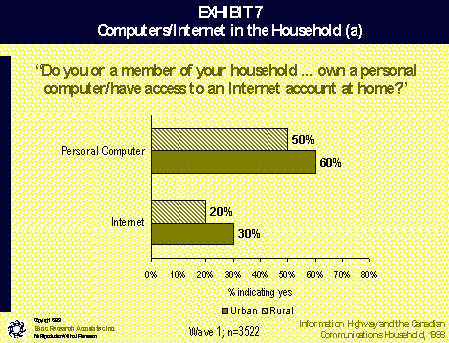
- Penetration rates also declined with community size [Exhibit 8]. In the largest urban
areas with more than 500,000 inhabitants, the computer and Internet penetration rates
were 66 per cent and 37 per cent. By contrast, the same rates were lowest in
communities with fewer than 1,000 inhabitants (48 per cent and 19 per cent
respectively).
- When probed about the reasons for not having either a personal computer or the
Internet at home, there were few differences between rural and urban respondents. In
both cases, more than four in ten cited a lack of interest or need as the reason (50 per
cent in rural areas and 45 per cent in urban areas).
- Similarly, rural and urban Canadians without access to the Internet from home both
seemed to perceive it as "nice to have" and shared little sense of urgency in acquiring
access. Only one in ten believed that not having access to the Internet from home
posed a problem [Exhibit 9].
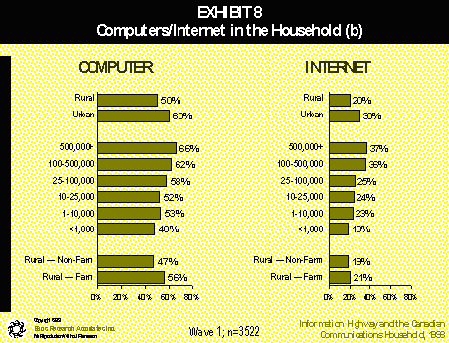
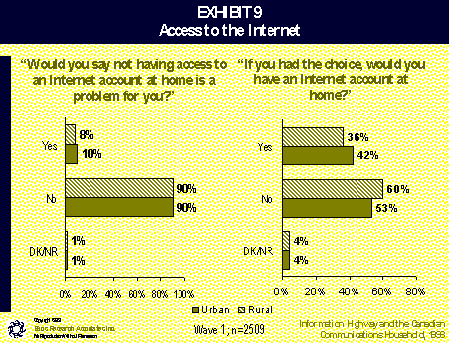
- In fact, only 36 per cent of rural respondents without access actually said that they
would want to have Internet in their household given the choice - a proportion
similar to the 42 per cent in urban areas [see Exhibit 9].
- Consistent with the above findings, further probing into attitudes towards the perceived importance of access to the Internet did not point to an overriding concern over Internet access. Compared to the telephone - and to a lesser extent television - the Internet is seen as far more optional at this stage. Differences between rural and urban respondents are small, with the largest gaps relating to the perceived importance of cable television [Exhibit 10].
- While long-distance charges apply to Internet access for some rural Canadians, it is believed to be a fairly small proportion. That being said, however, a surprising number of rural and urban Canadians alike perceived that long-distance phone charges apply to the Internet, a figure that could be reasonably assumed to overstate the true level. The perception that long-distance charges apply is even more pronounced among Canadians without home Internet access [Exhibit 11].
- About one in ten of those with home Internet access believe that long-distance charges apply to their Internet access (12 per cent in rural areas and 8 per cent in urban areas).
- Rural Canadians without home access were far more likely to believe that long-distance charges would apply (47 per cent as compared to 26 per cent in urban areas). Another third were unsure.
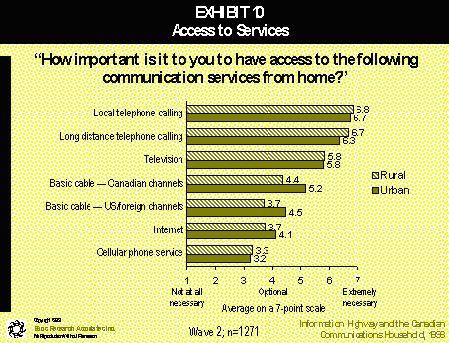

3.3 Barriers to the Information Highway
- While cost was a significant barrier behind many individuals not having a computer or household Internet access, it is by no means the only issue.
- Moreover, rural Canadians were not any more likely to cite cost as the reason for not having either than their urban counterparts. Overall, close to four in ten cited cost as the main reason for not having a computer (36 per cent in rural areas and 38 per cent in urban areas). Likewise, 18 per cent of rural respondents and 21 per cent of urban respondents cited cost as the reason in relation to not having Internet access.
- For both rural and urban Canadians alike, a lack of technical knowledge is seen as a more significant barrier to the information highway than not having the necessary hardware [Exhibits 12 and 13].
- More than half of rural and urban respondents believe that lack of knowledge is a barrier for most Canadians, and another one in five believes it to be somewhat of a barrier. By contrast, only one in three rural and urban respondents stated that access to equipment is a barrier, although 42 per cent of each believed that this is somewhat the case.
- Far fewer respondents believe that knowledge or equipment are significant barriers for themselves personally, although rural respondents are slightly more likely to perceive lack of knowledge as an impediment.


- As might be expected, there is considerable variation in whether individuals perceive their skills as being adequate. While almost all tend to self-rate their reading and writing skills as being average or above, far fewer express the same confidence in relation to working with computers and the Internet. Generally speaking, rural respondents are slightly less likely to perceive their computer and Internet skills as strong as their urban counterparts [Exhibit 14].
- Only 35 per cent of rural respondents rated their computer abilities as being above average compared to 47 per cent of urban respondents, resulting in a lower average rating of 3.6 on a 7-point scale (vs. 4.2 among urban respondents).
- Fewer than one in five rural respondents (19 per cent) rated their Internet skills as above average, compared to 32 per cent of urban respondents. On average, rural respondents reported a significantly lower rating (2.7 on a 7-point scale vs. 3.3 among urban respondents).
- Similarly, respondents living in larger urban areas were more likely to self-rate their computer and Internet skills as being stronger than those living in smaller areas [Exhibit 15].


3.4 Government and Technology
- The original study pointed to a general acceptance of the trend of governments towards placing greater reliance on new technologies in delivering programs and services to Canadians, although many Canadians still express strong preferences to retain the option of dealing directly with a person.
- At the same time, the original study also sought to place constituents' use of government technology in context. As a starting point, the broad findings pointed to the fact that telephone contact remains the most common means of interaction with the federal government for both rural and urban Canadians [Exhibit 16].
- In fact, both were more than twice as likely to have interacted by telephone (57 per cent in rural areas and 55 per cent in urban areas) than the second most commonly cited method of mail (25 per cent and 23 per cent respectively).
- Far fewer cited computers/e-mail or in-person communication, although urban respondents were slightly more likely to have done the latter (10 per cent vs. 6 per cent among rural respondents)
- Again, rural and urban Canadians held high levels of acceptance for less personal interactions with government. Asked about their preferred methods, both were more likely to place relatively greater emphasis on traditional mail, telephone and computers/e-mail [see Exhibit 16]. That being said, rural respondents were slightly less likely to point towards to computers/e-mail as their preferred method (10 per cent vs. 16 per cent in urban areas), in part likely reflecting lower levels of usage of these technologies.

- Consistent with the patterns of current interaction with governments, the differences between rural and urban respondents relating to other lines of questioning are not particularly pronounced. Both, for example, point to similar outlooks in relation to whether governments are moving too fast in their adoption of technology and whether they perceive government as being on the leading edge of technology [Exhibit 17]. Likewise, expectations towards using the Internet in the future for either getting government information on-line or applying for programs on-line are very similar [Exhibit 18].
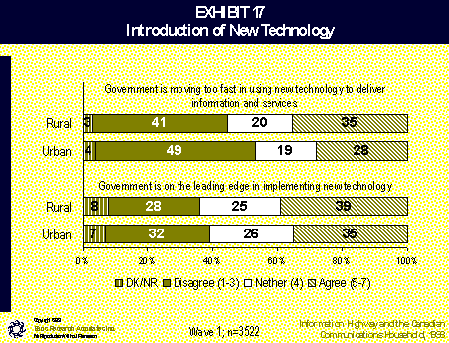
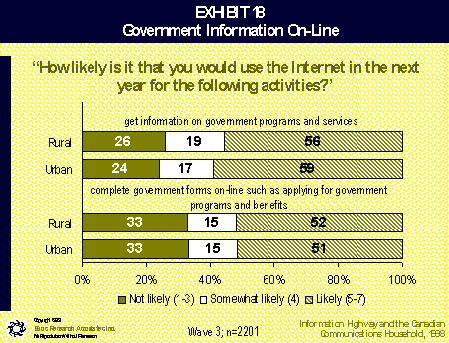
3.5 Electronic Commerce
- Overall, the broad study painted a picture where many rural and urban Canadians alike expect to take advantage of electronic or e-commerce, building on their growing acceptance and reliance on technology in relation to their personal finances and other consumer activities.
- As a starting point, a similar proportion of rural and urban Canadians reported having bank/debit cards and credit cards, although rural respondents were more likely to have a telephone calling card [Exhibit 19].

- While rural and urban Canadians were similar in terms of their payment of bills by mail, in-person at a bank or store or through automated withdrawals, those in rural areas were less likely to have done so over the telephone (14 per cent vs. 24 per cent in urban areas). Likewise, rural Canadians were less likely to have paid bills through a bank machine (37 per cent vs. 52 per cent in urban areas [Exhibit 20].
-
When probed about how individuals had purchased different products and services, the findings pointed to higher activity of purchases done through catalogues, mail order and over the telephone in rural areas [Exhibit 21]. Differences between the level of activity of purchases over the Internet were not observed, although the overall level of activity was quite small (only 3 per cent at the time of the study) and too early in the evolution of e-commerce to draw any firm conclusions.
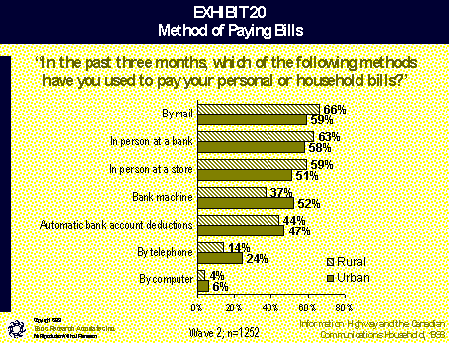

-
As mentioned, Canadians exhibit a definite preference towards using banking machines over doing their banking in-person with a teller (although these outlooks are less pronounced in rural areas). Likewise, debit cards are increasingly popular, and are preferred over cash, cheques, and credit cards by more than four in ten rural and urban respondents [Exhibit 22].

- E-commerce appears poised to grow rapidly over the next few years, building on strong expectations and rising comfort levels with the Internet as Canadians become more experienced users.
- While slightly less pronounced than in urban areas, one in three rural Canadians say that they expect to buy some products or services over the Internet within the next two years (compared to 40 per cent in urban areas) [Exhibit 23]. The broader findings suggested that certain individuals expect to become on-line consumers faster than other Canadians, with the highest expectations among males, younger and middle-aged Canadians, upper income groups, households already wired to the Internet, and those living in larger urban centres.
- At this stage, however, one of the largest inhibitors to expanded e-commerce activity still remains a widespread concern with the security of the medium and a reluctance to provide credit card numbers over the Internet. This is particularly the case in rural areas where far fewer are willing to offer this information over the Internet (4 per cent vs. 16 per cent in urban areas). Moreover, the broader study revealed that concerns relate more to the medium itself rather than the reputation of the business on-line.
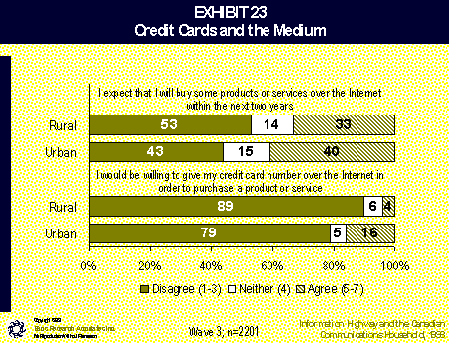


4 Looking to the Future
- The findings in this study point to a number of differences in the usage between rural and urban Canadians, and across small and large communities throughout Canada, with familiarity, usage, and expectations all being lower in rural and remote parts of the country.
- In some ways, these findings are somewhat ironic given that Canadians living outside urban areas are less likely to take advantage of the information highway at this stage despite having the most to gain from the way it is increasingly redefining Canadians' ability to access to services, information, and products.
- While some of the differences are pronounced, it is clear that we are still relatively early on in the movement on-line - both in terms of users and the various applications. Within this context, it will be important to monitor and assess how these trends unfold, particularly as the information highway grows in importance as both public and private sector organizations continue to place more emphasis on electronic service delivery methods as ways of reaching clients and citizens.
- As we look toward the future, one of the main questions raised in the broader study remains equally relevant. Will the adoption of some of the technologies such as the Internet follow a pattern with usage expanding from the "early adopters" and become part of the mainstream across all communities or will some of the existing gaps worsen? Likewise, will computers, the Internet and newer technological skill gaps between smaller and larger communities narrow or worsen?
|
Date Modified: 2002-08-20 |
|

[
|
|
|
| ]
[
|
|
|
| ]
|
|
|























